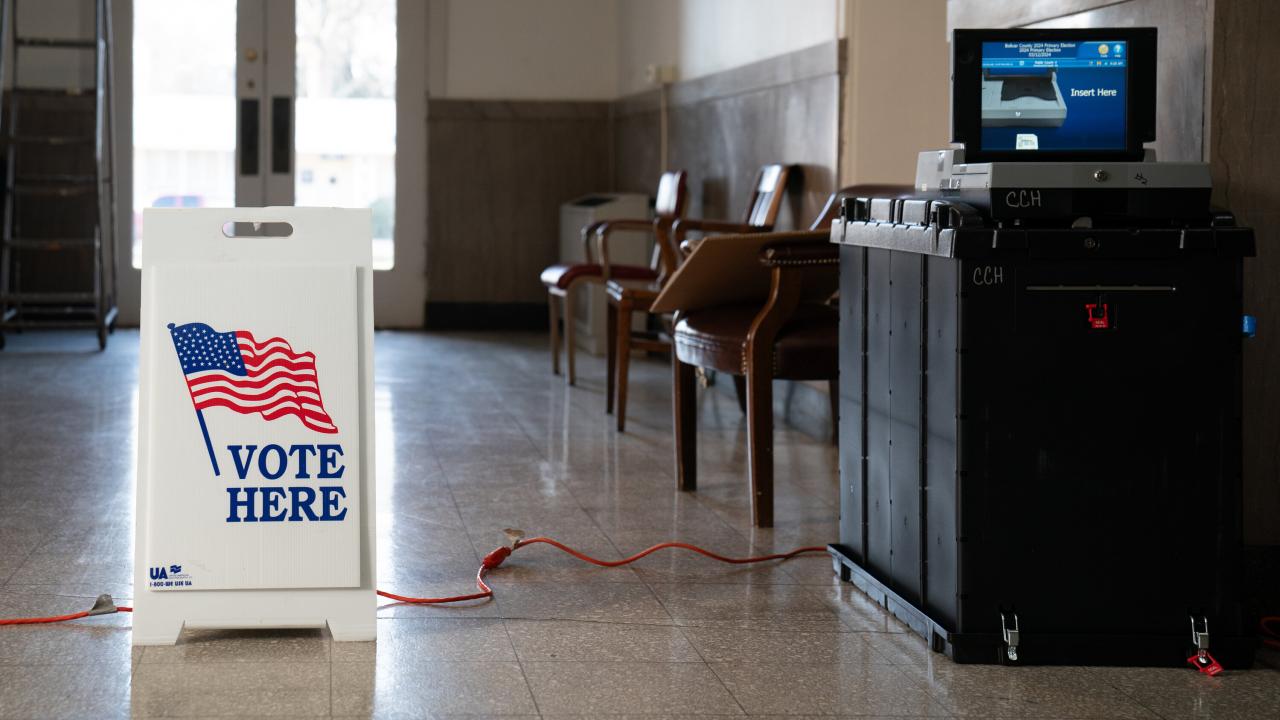
Cyber Attack Crashes Knox County Election Commission Website
Cyber attack crashes Knox County Election Commission website – that headline alone speaks volumes about the vulnerability of our election infrastructure. This incident isn’t just a technical glitch; it’s a stark reminder of the ever-present threat of cyberattacks targeting our democratic processes. The impact ripples far beyond a simple website outage, affecting voter confidence, election integrity, and even the county’s financial stability.
We’ll dive deep into the details of this attack, exploring its technical aspects, the response, and the crucial lessons learned.
From identifying the type of attack and the vulnerabilities exploited to examining the county’s response and recovery efforts, we’ll unpack the entire incident. We’ll also look at the legal and ethical implications, and most importantly, how to prevent similar attacks in the future. This isn’t just about technology; it’s about protecting our right to vote and ensuring faith in our elections.
Impact Assessment
The cyberattack that crippled the Knox County Election Commission website had immediate and potentially long-lasting consequences, extending beyond the simple inconvenience of website downtime. The incident highlights the vulnerability of election infrastructure to increasingly sophisticated cyber threats and underscores the need for robust security measures.The immediate impact was a disruption to several key election-related functions. Voters attempting to access information about polling locations, candidate information, or registration status were met with an inaccessible website.
This lack of access could have disenfranchisement for some voters, particularly those who rely heavily on online resources for election information. Internal operations within the Election Commission were also affected, potentially delaying critical tasks like processing registrations or updating voter rolls.
Consequences for Voter Confidence and Election Integrity
The attack’s impact on voter confidence and the perception of election integrity cannot be understated. A successful cyberattack, even if the underlying data remains secure, can erode public trust in the fairness and security of the electoral process. The perception of vulnerability can lead to decreased voter turnout, particularly among those already skeptical of the system. Similar incidents in other jurisdictions have shown a correlation between website disruptions and decreased voter participation in subsequent elections.
For example, the 2016 DDoS attack on the Arizona Secretary of State’s website, though ultimately unsuccessful in compromising data, led to significant public concern and criticism of election security.
Financial Implications for Knox County
The financial repercussions of the cyberattack are multifaceted. The immediate costs include the expense of restoring the website, engaging cybersecurity experts to investigate the breach, and potentially paying for forensic analysis to determine the extent of the intrusion. There may also be indirect costs associated with lost productivity within the Election Commission, the need for additional staff time spent addressing the crisis, and potential legal fees if lawsuits are filed.
The long-term costs could include upgrading cybersecurity infrastructure to prevent future attacks, which can represent a significant investment. Consider the cost incurred by the city of Atlanta after the 2018 ransomware attack, which cost millions in recovery and remediation efforts.
Comparison with Similar Incidents
The Knox County incident shares similarities with numerous other cyberattacks targeting election-related websites across the United States. Many of these incidents involved Distributed Denial-of-Service (DDoS) attacks, overwhelming the website with traffic to render it inaccessible. Others have involved more sophisticated attempts to breach security and compromise voter data. While the specifics of each attack vary, the common thread is the vulnerability of election infrastructure to cyber threats and the potential for significant disruption to the electoral process.
A comparative analysis of these incidents, focusing on the methods used, the impact on voter access, and the response from affected jurisdictions, could provide valuable insights for improving election security nationwide. Examples include the 2016 attacks on voter registration databases in Illinois and Arizona, highlighting the range of targets and consequences.
Technical Analysis of the Cyberattack
The Knox County Election Commission website crash points to a sophisticated and targeted attack, likely leveraging multiple vulnerabilities. While a definitive assessment requires deeper forensic analysis, the symptoms suggest a combination of techniques rather than a single attack vector. The scale and speed of the disruption strongly indicate a well-planned and executed operation.The most probable culprit is a Distributed Denial-of-Service (DDoS) attack, amplified by potential vulnerabilities in the website’s underlying infrastructure and application code.
This would explain the sudden, overwhelming traffic that brought the site down. However, a DDoS attack alone might not fully account for the severity and persistence of the outage; other attack vectors were likely employed.
Likely Attack Types and Exploited Vulnerabilities
The attackers likely employed a multi-pronged approach. A DDoS attack, flooding the server with illegitimate traffic from numerous sources, created the initial disruption. Simultaneously, they may have exploited known vulnerabilities in the website’s content management system (CMS) or other software components. SQL injection is a strong possibility, given the sensitive nature of election data held by the commission. A successful SQL injection attack could have allowed attackers to manipulate the database, potentially stealing data or causing further system instability, compounding the effects of the DDoS.
Another possibility is a vulnerability in the web server itself, allowing for unauthorized access and control.
Attack Methods
The DDoS component could have been achieved using botnets, networks of compromised computers controlled remotely to generate massive amounts of traffic towards the target server. For the SQL injection, the attackers likely identified and exploited a weakness in the website’s input validation or sanitization processes. This could have been achieved through automated scanning tools that identify common vulnerabilities, followed by manual testing to refine the attack.
They may have also used social engineering techniques to gain access to administrative credentials, providing a backdoor for more insidious attacks. The combination of these approaches allowed for both a high-impact denial-of-service attack and the potential for data exfiltration.
Hypothetical Timeline of Events
The attack likely unfolded over several stages. First, reconnaissance: attackers scanned the website for known vulnerabilities using automated tools. This could have taken days or weeks. Next, exploitation: They identified and exploited vulnerabilities, possibly through SQL injection or other means to gain unauthorized access. This may have happened hours or days before the DDoS.
Then, the DDoS attack: The botnet was unleashed, flooding the server with traffic, causing the website to crash. This was the most visible phase of the attack. Finally, post-attack activity: Attackers might have attempted to maintain access or exfiltrate data even after the website was taken down, potentially exploiting the chaos to further their objectives. This phase could be ongoing.
This scenario mirrors several real-world attacks, such as the 2016 DDoS attack on Dyn, which crippled major websites, and numerous SQL injection attacks against government websites resulting in data breaches.
Security Measures and Protocols

The Knox County Election Commission website attack highlighted critical vulnerabilities in their existing cybersecurity infrastructure. Understanding the pre-existing security measures and the necessary improvements is crucial for preventing future incidents and ensuring election integrity. This section details the known security protocols before the attack and proposes a comprehensive plan for enhanced website security.Existing Cybersecurity Protocols Before the Attack: While specific details about the Knox County Election Commission’s pre-attack security protocols are not publicly available, it’s reasonable to assume that some basic measures were in place.
These likely included firewall protection, basic anti-virus software, and potentially password policies. However, the severity of the attack suggests significant deficiencies in these measures, likely lacking robust intrusion detection and prevention systems, regular security audits, and comprehensive employee training on cybersecurity best practices. The lack of multi-factor authentication was likely a significant contributing factor.
Improvements Needed to Prevent Future Cyberattacks
The attack underscores the need for a multi-layered approach to website security. This requires significant upgrades beyond basic protection. Improvements must include implementing robust intrusion detection and prevention systems (IDPS), regularly scheduled security audits by independent cybersecurity experts, and comprehensive employee training programs focusing on phishing awareness, password management, and secure coding practices. A critical component is the implementation of multi-factor authentication (MFA) for all administrative accounts and potentially for voter access depending on the system design.
Furthermore, a detailed incident response plan should be developed and regularly tested to ensure a swift and effective response to future security incidents. This plan should include clear communication protocols to inform stakeholders and the public. Finally, regular vulnerability scans and penetration testing are essential to proactively identify and address security weaknesses before they can be exploited.
Enhanced Website Security Plan
A comprehensive plan for enhanced website security must encompass several key areas. First, a robust intrusion detection and prevention system (IDPS) should be implemented to monitor network traffic for malicious activity and automatically block suspicious connections. This should be complemented by a web application firewall (WAF) to protect against common web application vulnerabilities such as SQL injection and cross-site scripting (XSS).
Second, regular backups of the website’s data and configuration should be performed, ideally stored offline in a secure location to protect against data loss in the event of a successful attack. These backups should be regularly tested for recoverability. Third, an incident response plan should be developed and tested, outlining clear steps to be taken in the event of a security breach.
This plan should include procedures for containing the breach, recovering data, and communicating with stakeholders. Finally, employee training and awareness programs are critical to preventing human error, a common vector for cyberattacks.
Best Practices for Election Website Security
The following table Artikels best practices for securing election websites. These practices, implemented effectively, significantly reduce the risk of successful cyberattacks. The cost and effectiveness estimations are general and can vary based on specific implementations and vendor choices.
| Security Measure | Implementation Details | Cost | Effectiveness |
|---|---|---|---|
| Multi-Factor Authentication (MFA) | Implement MFA for all administrative accounts and potentially voter accounts, using methods like TOTP or FIDO2. | Medium – High (depending on the chosen solution and number of users) | High – significantly reduces the risk of unauthorized access |
| Intrusion Detection/Prevention System (IDPS) | Deploy a network-based IDPS and a host-based IDPS to monitor for malicious activity and automatically block threats. | Medium – High (depending on the chosen solution and network size) | High – detects and prevents many types of attacks |
| Web Application Firewall (WAF) | Implement a WAF to protect against common web application vulnerabilities such as SQL injection and XSS. | Medium – High (depending on the chosen solution and traffic volume) | High – protects against many common web application attacks |
| Regular Security Audits | Conduct regular security audits by independent cybersecurity experts to identify and address vulnerabilities. | Medium – High (depending on the scope and frequency of audits) | High – proactively identifies and addresses vulnerabilities |
| Regular Backups | Implement a robust backup and recovery system with offline storage of backups. | Low – Medium (depending on the storage solution and data volume) | High – ensures data recovery in case of an attack or disaster |
| Employee Security Training | Provide regular security awareness training to all employees to educate them on phishing, social engineering, and secure coding practices. | Low – Medium (depending on the training program and number of employees) | High – reduces the risk of human error |
| Vulnerability Scanning and Penetration Testing | Regularly scan for vulnerabilities and conduct penetration testing to simulate real-world attacks. | Medium – High (depending on the scope and frequency of testing) | High – proactively identifies and addresses vulnerabilities |
Response and Recovery Efforts

The Knox County Election Commission’s response to the cyberattack was swift and multifaceted, prioritizing the restoration of website functionality and the assurance of election integrity. The immediate actions taken were crucial in mitigating further damage and maintaining public trust. The recovery process involved a coordinated effort across various departments and external cybersecurity experts.The restoration of the website and election operations involved a phased approach.
First, the compromised systems were isolated to prevent further data breaches. This involved shutting down the website temporarily and disconnecting affected servers from the network. Simultaneously, data backups were analyzed for integrity and viability. Once a clean backup was identified, the website was rebuilt on a new, secure server infrastructure. Rigorous security testing was conducted before the website was brought back online.
To ensure continued election operations, alternative methods for voter registration and information access were implemented, including temporary phone lines and in-person assistance at designated locations.
Communication Strategies
The Election Commission employed a multi-pronged communication strategy to keep voters informed throughout the incident. Press releases were issued promptly, detailing the nature of the attack and assuring voters that their data security was a top priority. Regular updates were posted on social media platforms, including Facebook and Twitter, and local news outlets were actively engaged to disseminate information widely.
The Commission also utilized email notifications to registered voters, providing timely updates and instructions on accessing election information through alternative channels. This proactive communication helped maintain transparency and prevented the spread of misinformation.
Post-Incident Investigation Findings
The post-incident investigation was thorough and comprehensive, involving both internal and external cybersecurity experts. The investigation aimed to identify the root cause of the attack, the extent of the damage, and to implement preventative measures. The key findings are summarized below:
- The attack was determined to be a sophisticated ransomware attack leveraging a zero-day vulnerability in outdated software.
- No voter registration data was exfiltrated; however, some non-sensitive website files were encrypted.
- The attack was traced back to a known hacking group operating from an overseas location.
- The investigation revealed deficiencies in the Commission’s security protocols, specifically concerning regular software updates and multi-factor authentication.
- Recommendations for enhanced security measures, including improved vulnerability management, employee security awareness training, and the implementation of advanced threat detection systems, were developed and implemented.
Legal and Ethical Considerations
The Knox County election website cyberattack raises significant legal and ethical questions concerning data security, voter privacy, and the county’s response to the incident. Understanding the legal ramifications for both the county and potential perpetrators, as well as analyzing the ethical implications of the breach, is crucial for preventing future incidents and ensuring public trust. This section will explore these considerations in detail.
Legal Ramifications of the Cyberattack
The legal ramifications of the cyberattack are multifaceted and depend heavily on the specifics of the attack, including the nature of the data compromised, the perpetrator’s identity, and the extent of the damage. Knox County could face legal action from voters whose data was compromised, potentially under state or federal privacy laws. These laws vary, but often include provisions for notification of breaches, data security requirements, and potential penalties for non-compliance.
Furthermore, depending on the severity of the disruption to the election process, the county could face legal challenges related to voter disenfranchisement. Potential perpetrators, if identified, could face criminal charges under federal laws like the Computer Fraud and Abuse Act (CFAA) or state laws concerning unauthorized access to computer systems and data theft. The penalties for such crimes can range from significant fines to lengthy prison sentences.
The investigation will need to determine whether the attack was an act of malicious intent, negligence, or a combination of both, which will significantly impact the legal consequences.
Ethical Considerations Related to Data Security and Voter Privacy
The cyberattack raises serious ethical concerns regarding the protection of sensitive voter data. The principle of data minimization dictates that only necessary data should be collected and retained, and that data should be securely stored and protected from unauthorized access. The attack highlights a failure to uphold this principle. Further ethical concerns arise from the potential for misuse of compromised voter data, including voter intimidation, identity theft, or targeted disinformation campaigns.
The county has an ethical obligation to ensure the confidentiality, integrity, and availability of voter data, and the breach represents a significant failure to meet these obligations. Transparency and accountability are also crucial; the county must be open and honest with voters about the extent of the breach and the steps being taken to address it.
Comparison of Knox County’s Response with Best Practices
Knox County’s response to the cyberattack should be evaluated against established best practices for handling election security breaches. These best practices generally include swift identification and containment of the breach, notification of affected individuals and relevant authorities, a thorough investigation to determine the cause and extent of the damage, implementation of improved security measures, and ongoing monitoring for future threats.
A comparison would assess the timeliness and effectiveness of Knox County’s actions against these benchmarks. Areas where the county’s response fell short should be identified, along with recommendations for improvement. This analysis could involve comparing the Knox County incident response to similar incidents in other jurisdictions to identify best practices and lessons learned. For instance, a comparison with the response to the 2016 election interference attempts could provide valuable insights.
Reporting Election-Related Cyber Incidents, Cyber attack crashes knox county election commission website
Prompt and accurate reporting of election-related cyber incidents is critical for mitigating damage and coordinating a timely response. The process generally involves several key steps:
- Internal Reporting: Immediately report the incident to internal IT and election officials.
- State and Local Authorities: Report the incident to the appropriate state and local law enforcement agencies, such as the state’s cybersecurity task force or the local sheriff’s department.
- Federal Authorities: Report the incident to federal agencies such as the Cybersecurity and Infrastructure Security Agency (CISA) and the FBI, particularly if the incident involves federal election systems or appears to be part of a larger, coordinated attack.
- Notification of Affected Voters: As soon as possible, notify voters whose data may have been compromised, providing clear and concise information about the nature of the breach and steps they can take to protect themselves.
Voter Impact and Trust
The cyberattack that crippled the Knox County Election Commission website had a significant and multifaceted impact on voters, extending beyond the immediate inconvenience of website inaccessibility. The incident raised serious concerns about the security of the election process and eroded public trust in the integrity of the system. Understanding these impacts and implementing effective strategies to rebuild confidence is crucial for maintaining faith in democratic processes.The website crash directly affected voter access to critical information.
Potential voters were unable to register online, access polling place locations, or review candidate information during a crucial period. This lack of access disproportionately impacted individuals with limited internet access or those who rely on online resources for election-related information. Furthermore, the disruption fueled uncertainty and anxiety among voters, creating a climate of distrust and speculation. The incident served as a stark reminder of the vulnerability of election systems to cyberattacks and the potential for such attacks to undermine public confidence in the fairness and transparency of elections.
Impact on Voter Access to Information and Registration
The website outage prevented voters from accessing essential election-related information, such as candidate details, polling locations, and registration deadlines. This lack of access created significant barriers to participation, particularly for those who rely on online resources for election information. The inability to register online also disenfranchised individuals who may have missed the in-person registration deadline due to the website’s unavailability.
The Knox County election commission website crash due to a cyberattack highlights the critical need for robust, secure systems. Building resilient applications requires a modern approach, and that’s where learning about domino app dev the low code and pro code future becomes crucial. Understanding these development methods could help prevent future vulnerabilities like those exploited in this recent attack, ensuring vital public services remain online.
The impact was particularly acute for first-time voters or those unfamiliar with alternative registration methods. The situation mirrors similar incidents in other counties, where website outages during election periods have led to decreased voter turnout and widespread frustration. For example, the 2018 midterm elections saw several counties experience website crashes, leading to significant voter disenfranchisement and negative media coverage.
Erosion of Public Trust in Election Processes
The cyberattack significantly damaged public trust in the security and integrity of the Knox County election system. The incident fueled concerns about the vulnerability of the system to future attacks and raised questions about the ability of election officials to safeguard sensitive voter data. This erosion of trust can have long-term consequences, leading to decreased voter participation and increased skepticism about election outcomes.
The lack of transparency surrounding the attack initially exacerbated the situation, leading to speculation and misinformation among voters. The incident highlights the importance of proactive measures to protect election infrastructure and maintain public confidence in the electoral process. The loss of trust in elections is a serious issue, with studies showing a correlation between perceived insecurity and decreased voter turnout.
Strategies to Rebuild Public Confidence
Rebuilding public trust requires a multi-pronged approach that emphasizes transparency, accountability, and demonstrable improvements in election security. This includes promptly communicating with voters about the incident, detailing the nature of the attack, and outlining the steps taken to address the vulnerabilities. Furthermore, investing in robust cybersecurity infrastructure and conducting regular security audits are crucial. Transparency about security measures, including the use of encryption and multi-factor authentication, can help reassure voters.
The Knox County election commission website crash due to a cyberattack highlights the urgent need for robust online security. Understanding how to effectively manage cloud security is crucial, and learning more about solutions like Bitglass, as detailed in this insightful article on bitglass and the rise of cloud security posture management , could prevent similar incidents. Ultimately, stronger cybersecurity measures are essential to protect our election infrastructure from future attacks.
Proactive communication through town halls, public forums, and social media campaigns can help directly address concerns and counter misinformation. A commitment to continuous improvement and a demonstration of a strong security posture are essential for regaining and maintaining public trust. For instance, counties that have successfully rebuilt public trust after similar incidents have emphasized proactive communication, transparent investigations, and demonstrable improvements in their security systems.
Engaging with Voters to Address Concerns and Misinformation
A comprehensive communication plan is crucial for engaging with voters and addressing concerns following the attack. This plan should involve multiple channels, including social media, local news outlets, community forums, and direct mail. The messaging should be clear, concise, and factual, avoiding technical jargon and addressing voter concerns directly. This plan should also actively counter misinformation by providing accurate information and debunking false narratives.
Town hall meetings and public forums provide opportunities for direct engagement with voters, allowing election officials to answer questions and address concerns directly. Furthermore, working with community leaders and trusted organizations to disseminate information can help reach a broader audience and build trust. This approach mirrors successful communication strategies used by other counties facing similar challenges, where proactive engagement and transparent communication have been key to rebuilding public confidence.
Final Summary: Cyber Attack Crashes Knox County Election Commission Website

The Knox County election website attack serves as a potent warning. It underscores the critical need for robust cybersecurity measures in all aspects of our election systems. While the immediate crisis may have passed, the long-term implications for voter confidence and the integrity of future elections remain. The lessons learned from this incident should guide the development of more resilient and secure election infrastructure, ensuring that future elections are not vulnerable to similar disruptions.
We must remain vigilant and proactive in protecting our democratic process from the ever-evolving threats of the digital age.
Clarifying Questions
What type of data was potentially compromised?
The exact nature of compromised data, if any, hasn’t been fully disclosed. However, voter registration information and potentially other sensitive data could have been at risk.
How long was the website down?
The exact downtime is not publicly available but reports suggest it was several hours, impacting voter access to information.
Who is responsible for investigating the attack?
Likely a joint effort involving Knox County IT, potentially state and federal agencies, and possibly private cybersecurity firms.
What is the estimated cost of the attack to Knox County?
The financial impact is still being assessed, but it includes costs for website restoration, investigation, potential legal fees, and reputational damage.





